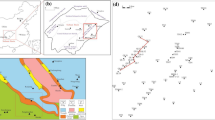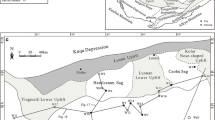Abstracts
It is favorable that the sequence-stratigraphic characteristic and sedimentology analysis of Paleogene and the associated deposits of Shahejie formation (FM.) be allowed a number of sedimentary evolution stages to be characterized and a sedimentary model of the lower second submember of Shahejie FM. (ES2) to be established. An integration of drilling, logging, testing, core descriptions, and high-resolution sequence stratigraphy has been used to provide a new conceptual depositional model for the M1 block; the results show that the lower ES2 is deposited as terminal fan, occurring in areas where sediment-laden waters decrease in size and vanish because of evaporation. The depositional model is composed of proximal subfacies, middle subfacies, and remote subfacies according to its lithology, electricity, and sedimentary structures. The combined analysis of lithological and sedimentary sequences has come to the conclusion that there are three levels of base level cycles and three kinds of interfacies for the lower ES2. The former includes fifth-order short-term cycle sequence (V), fourth-order medium-term cycle sequence (IV), and third-order long-term cycle sequence (III), respectively. The latter includes the scoured surface, the bedding change interface, and the thickness’ cyclic changing interface of sandstone and mudstone. The conclusion has been drawn that the lower ES2 of the M1 block is determined as a transgression process with increasing water depth based on the analysis and correlation of vertical stacking pattern.






Similar content being viewed by others
References
Adriana CM, Alberto TC (2012) Paleolimnology evolution in rift basins: the Ischigualasto-Villa Unión Basin (Central-Western Argentina) during the Triassic. Sediment Geol 275–276:38–54
Amorosi A, Marchi N (1999) High-resolution sequence stratigraphy from piezocone tests: an example from the Late Quaternary deposits of the southeastern Po Plain. Sediment Geol 128:67–81
Beatriz B, Marc A, Maider A, Idoia R, José C Gr, Laura P (2012) Sedimentary and chemostratigraphic record of climatic cycles in Lower Pliensbachian marl–limestone platform successions of Asturias (North Spain), Sedimentary Geology 119–138
Böhm F, Westphal H, Bornholdt S (2003) Required but disguised: environmental signals in limestone–marl alternations. Palaeogeogr Palaeoclimatol Palaeoecol 189:161–178
Bottrell S, Raiswell R (1989) Primary versus diagenetic origin of blue Lias rhythms (Dorset, UK): evidence from sulphur geochemistry. Terra Nova 1(5):451–456
Bourquin S, Friedenberg R, Guillocheau F (1995) Depositional sequences in the Triassic series of the Paris basin: geodynamic implications. J Iber Geol 19:337–362
Bourquin S, Rigollet C, Bourges P (1998) High-resolution sequence stratigraphy of an alluvial fan-fan delta environment: stratigraphic and geodynamic implications and an example from the Keuper Chaunoy sandstones, Paris Basin. Sediment Geol 121(3–4):207–237
Bourquin S, Person S, Durand M (2006) Lower Triassic sequence stratigraphy of the western part of the Germanic Basin (west of Black Forest): fluvial system evolution through time and space. Sediment Geol 186(3–4):187–211
Elliott T (1974) Interdistributary bay sequences and their genesis. Sedimentology 21:611–622
Eriksson PG, Reczko BF, Jaco BA, Schreiber UM (1995) Architectural elements from lower Proterozoic braid-delta and high-energy tidal flat deposits in the Magaliesberg Formation, Transvaal Supergroup, South Africa. Sediment Geol 97:99–117
George GT (1999) Characterisation and high resolution sequence stratigraphy of storm-dominated braid delta and shoreface sequences from the Basal Grit Group (Namurian) of the South Wales Variscan peripheral foreland basin. Mar Pet Geol 17:445–475
Kelly SB, Olsen H (1993) Terminal fans: a review with reference to Devonian examples. Sediment Geol 85(1–4):339–374
Schwarzacher W (2000) Repetitions and cycles in stratigraphy. Earth Sci Rev 50:51–75
Stow D A V, Tabrez A R (1998) Hemipelagites: processes, facies and model. Geological processes on continental margins: In: Stoker, M. S., Evans, D., Cramp, A. (Eds.), Geological Society, London, Special Publications 129: 317–337
Wang GH, Liu ZL, Li QY (2011) Fine structure interpretation and reservoir prediction of Wenmingzhai Oilfield-a case of S2 reservoir for M1 block [J]. Geophys Prospect Pet 50(2):165–172 (in Chinese)
Zhang JL, Jiang ZQ, Li DY, Sun J (2009) Sequence stratigraphic analysis of the first layer, upper second submember, Shahejie Formation in Pucheng oilfield. J Earth Sci 20(6):932–940
Acknowledgments
The authors wish to thank SINOPEC Zhongyuan Petroleum Exploitation Bureau Geoscience Institute for financially supporting the research project.
Author information
Authors and Affiliations
Corresponding author
Rights and permissions
About this article
Cite this article
Li, X., Zhang, J., Xie, J. et al. Sedimentary and sequence-stratigraphic characteristics of the lower second submember, Shahejie formation, M1 block, Wenmingzhai oilfield, Dongpu depression, China. Arab J Geosci 8, 5397–5406 (2015). https://doi.org/10.1007/s12517-014-1579-4
Received:
Accepted:
Published:
Issue Date:
DOI: https://doi.org/10.1007/s12517-014-1579-4




